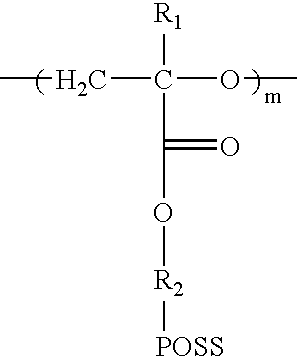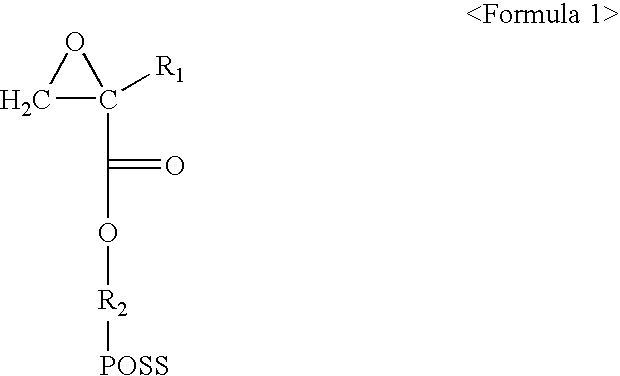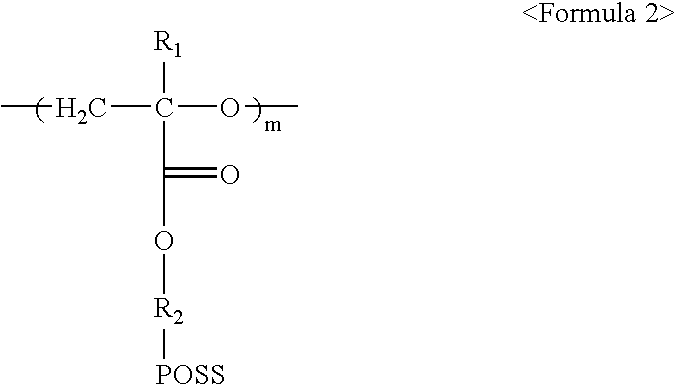Monomer for forming organic Anti-reflective coating layer, polymer thereof and composition including the same
- Summary
- Abstract
- Description
- Claims
- Application Information
AI Technical Summary
Benefits of technology
Problems solved by technology
Method used
Image
Examples
example 1
Preparation of Methacrylate-POSS Oxide Monomer
A. Preparation of Monomer Represented by Formula 1a
[0045]As shown in the following Reaction 1, 30 g(0.033 mol) of monomer represented by Formula 9a and 1 L of chloroform were added into 2 L reactor in which a magnetic stirring rod was provided and the reactor was cooled with iced water. After 10 g(0.058 mol) of 3-chloroperoxybenzoic acid was slowly added to the cooled reactor, the reaction was carried out at room temperature for 24 hours. After the completion of the reaction, the 3-chlorobenzoic acid (by-product) was removed by filtering the product, and then the remaining 3-chlorobenzoic acid was further removed by washing 2 times with saturated sodium sulfite aqueous solution, 1 time with saturated sodium bicarbonate aqueous solution, 1 time with saturated sodium chloride aqueous solution, and 1 time with distilled water. Next, the product was dried with magnesium sulfate, and chloroform was removed under reduced pressure, and then the...
example 2
Preparation of Methacrylate-POSS Oxide Polymer
[0055]A. Preparation of polymer represented by Formula 2a
[0056]As shown in the following Reaction 2, 15 g of monomer of Formula 1a prepared in A of Example 1 was added into 500 mL reactor in which a magnetic stirring rod was provided, and dissolved with 300 mL of dichloromethane. The reaction solution was cooled with iced water. Next, 3 mL of borontrifluoride diethylether, which is a polymerization catalyst, was very slowly and dropwisely added to the solution with a syringe. After increasing temperature of the reaction solution to room temperature, the reaction was carried out under nitrogen atmosphere for 4 days. After completion of the reaction, the reaction product was precipitated by being poured into 3 L water, and the pure solid reaction product was obtained. The obtained product was filtered and dried to obtain 12 g of the polymer represented by Formula 2a (m=10, Mw=9,570).
B. Preparation of Polymer Represented by Formula 2b
[0057]...
example 3
Preparation of Copolymer
[0066]A˜E. Preparation of copolymer s represented by Formula 3
[0067]Two compounds shown in the following Table 1 were added into 1 L reactor in which a magnetic stirring rod was provided, and dissolved with 500 mL of dichloromethane. The reaction solution was cooled with iced water. Next, 3 mL of borontrifluoride diethylether, which is a polymerization catalyst, was very slowly and dropwisely added to the solution with a syringe. After increasing temperature of the reaction solution to room temperature, the reaction was carried out under nitrogen atmosphere for 4 days. After completion of the reaction, the reaction product was precipitated by being poured into 3 L water, and the pure solid reaction product was obtained. The obtained product was filtered and dried to obtain copolymer of Formula 3. The amounts of repeating units (mol %), weight-average molecular weight (Mw), polydispersity (PDI) and yield(%) of the produced copolymer are set forth in the follow...
PUM
| Property | Measurement | Unit |
|---|---|---|
| Percent by mass | aaaaa | aaaaa |
| Percent by mass | aaaaa | aaaaa |
| Fraction | aaaaa | aaaaa |
Abstract
Description
Claims
Application Information
 Login to View More
Login to View More - Generate Ideas
- Intellectual Property
- Life Sciences
- Materials
- Tech Scout
- Unparalleled Data Quality
- Higher Quality Content
- 60% Fewer Hallucinations
Browse by: Latest US Patents, China's latest patents, Technical Efficacy Thesaurus, Application Domain, Technology Topic, Popular Technical Reports.
© 2025 PatSnap. All rights reserved.Legal|Privacy policy|Modern Slavery Act Transparency Statement|Sitemap|About US| Contact US: help@patsnap.com



